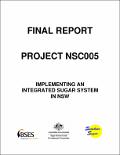| Abstract | The New South Wales Sugar Milling Co-operative’s (NSWSMC) move to whole cane harvesting for cogeneration will increase in-field haulout traffic by 30% with the potential for yield decline due to increased soil compaction. Trials were established in all three milling areas of NSW in 2003 comparing various controlled traffic (1.8 m) row spacing/ planting configurations with the conventional 1.5 m configuration. Results obtained for both one and two-year crops are reported. The trial results have indicated the potential for small yield increases and demonstrated that adoption of controlled traffic cropping systems will not result in loss of productivity. These results have given growers confidence that they can adopt a controlled traffic farming system without productivity losses. Although there were generally no major yield differences between the three controlled traffic systems evaluated, it is considered that the dual row configuration is the best option for NSW given the slower canopy closure in the other 1.8 m configurations. In addition, it is possible to zero till dual rows with double disc planting technology but this option is not possible for a wide row configuration. However the construction of the wide throat strip tillage machinery has enabled a reduced tillage option for wide throat plantings. Further trials were established in 2004 comparing fallow plant with replant to determine the effect of a legume break on the yield of the following cane crop. These trials also included tillage treatments to observe effect on zero-tilling cane through soybean stubble. These trials were established with a stalk planter, with results showing no yield penalty through zero-tilling cane. In 2005 trials were established comparing conventional tillage with zero-tillage using a disc-opener billet planter, similarly results showed no yield penalty from zero-tilling cane through soybean stubble. An economic analysis indicated that by adopting a controlled traffic, reduced tillage, legume fallow system, on a 72ha farm, a grower will improve gross margins by $12,857 when compared to a conventional system. Variable costs such as fertiliser and fuel are greatly reduced in such a system. Harvester operator visibility when cutting large two-year old crops green is severely limited due to the increased bulk of cane material so GPS guidance systems (± 2 cm) were evaluated in these trials. As a result of these trials the NSW industry has established an RTK GPS base station network, with coverage of all three mill areas. The entire harvesting fleet in Broadwater and Condong have been set up with GPS guidance in readiness for whole-of-crop harvesting, with a number of units being set up on growers’ tractors. A total of 60 GPS units are now operating on the NSWSMC base station network. A large scale extension program was undertaken throughout the life of the project with numerous field days, shed meeting, farm walks being conducted to increase the awareness among growers of the benefits of adopting the new farming system. As a result adoption of controlled traffic farming has increased dramatically since trial work began in NSW 2003. This has been a result of a broad scale extension program advocating the results of the farming systems work along with innovative growers making a successful transition to controlled traffic farming. |

